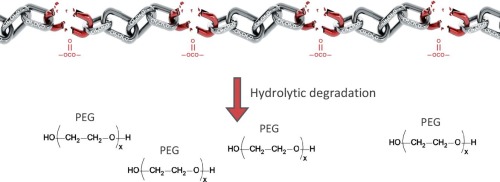当前位置:
X-MOL 学术
›
Eur. Polym. J.
›
论文详情
Our official English website, www.x-mol.net, welcomes your
feedback! (Note: you will need to create a separate account there.)
Hydrolytically degradable poly(ethylene glycol) based polycarbonates by organocatalyzed condensation
European Polymer Journal ( IF 5.8 ) Pub Date : 2017-10-01 , DOI: 10.1016/j.eurpolymj.2017.06.046 Leire Meabe , Haritz Sardon , David Mecerreyes
European Polymer Journal ( IF 5.8 ) Pub Date : 2017-10-01 , DOI: 10.1016/j.eurpolymj.2017.06.046 Leire Meabe , Haritz Sardon , David Mecerreyes

|
Abstract Poly(ethylene glycol) is one of the most used stealth polymer in the field of polymer-based drug delivery. In spite of its excellent biocompatibility, high molecular poly(ethylene glycol) can be accumulated in the body, in contrast to low molar mass one. This is due to the non-degradability of poly(ethylene glycol) which can cause some negative side effects. In order to overcome this drawback, in this work we present new degradable high molecular poly(ethylene glycol) by simply incorporating carbonate groups between poly(ethylene glycol) units. Thus, poly(ethylene glycol) based polycarbonates have been synthesized by polycondensation of dimethyl carbonate and poly(ethylene glycol) of four different low molar masses; 600, 1000, 1500 and 2000 g mol −1 . Optimum bulk polycondensation reactions were run in two steps in the presence of 4-dimethylaminopyridine organocatalyst. By this method, poly(ethylene glycol) based polycarbonates were prepared and characterized showing molar masses between 10 and 35 kg mol −1 and crystallinity was increased compared to the initial low molar mass poly(ethylene glycol)s. The hydrolytic degradation of the poly(ethylene glycol) based polycarbonates was investigated in vitro using a phosphate buffer solution at pH = 7.2. The results showed that the initial poly(ethylene glycol)-polycarbonates hydrolyzed by the carbonate units showing a decrease of molar mass as a function of time. It was found that all polycarbonates underwent almost complete hydrolysis after 50 days leading to the initial low molar mass poly(ethylene glycol) units that are bellow renal clearance threshold.
中文翻译:

通过有机催化缩合可水解降解的聚(乙二醇)基聚碳酸酯
摘要 聚乙二醇是聚合物基药物递送领域应用最广泛的隐形聚合物之一。尽管具有出色的生物相容性,但与低摩尔质量的聚乙二醇相比,高分子聚(乙二醇)可以在体内积累。这是因为聚(乙二醇)的不可降解性会导致一些负面影响。为了克服这个缺点,在这项工作中,我们通过在聚(乙二醇)单元之间简单地加入碳酸酯基团来提出新的可降解高分子聚(乙二醇)。因此,聚(乙二醇)基聚碳酸酯已通过四种不同低摩尔质量的碳酸二甲酯和聚(乙二醇)的缩聚反应合成;600、1000、1500和2000克摩尔 -1 。最佳本体缩聚反应在 4-二甲氨基吡啶有机催化剂的存在下分两步进行。通过这种方法,制备并表征了聚(乙二醇)基聚碳酸酯,显示摩尔质量在 10 至 35 kg mol -1 之间,并且与初始低摩尔质量聚(乙二醇)相比,结晶度增加。使用 pH = 7.2 的磷酸盐缓冲溶液在体外研究了基于聚(乙二醇)的聚碳酸酯的水解降解。结果表明,由碳酸酯单元水解的初始聚(乙二醇)-聚碳酸酯显示摩尔质量随时间的降低。
更新日期:2017-10-01
中文翻译:

通过有机催化缩合可水解降解的聚(乙二醇)基聚碳酸酯
摘要 聚乙二醇是聚合物基药物递送领域应用最广泛的隐形聚合物之一。尽管具有出色的生物相容性,但与低摩尔质量的聚乙二醇相比,高分子聚(乙二醇)可以在体内积累。这是因为聚(乙二醇)的不可降解性会导致一些负面影响。为了克服这个缺点,在这项工作中,我们通过在聚(乙二醇)单元之间简单地加入碳酸酯基团来提出新的可降解高分子聚(乙二醇)。因此,聚(乙二醇)基聚碳酸酯已通过四种不同低摩尔质量的碳酸二甲酯和聚(乙二醇)的缩聚反应合成;600、1000、1500和2000克摩尔 -1 。最佳本体缩聚反应在 4-二甲氨基吡啶有机催化剂的存在下分两步进行。通过这种方法,制备并表征了聚(乙二醇)基聚碳酸酯,显示摩尔质量在 10 至 35 kg mol -1 之间,并且与初始低摩尔质量聚(乙二醇)相比,结晶度增加。使用 pH = 7.2 的磷酸盐缓冲溶液在体外研究了基于聚(乙二醇)的聚碳酸酯的水解降解。结果表明,由碳酸酯单元水解的初始聚(乙二醇)-聚碳酸酯显示摩尔质量随时间的降低。











































 京公网安备 11010802027423号
京公网安备 11010802027423号